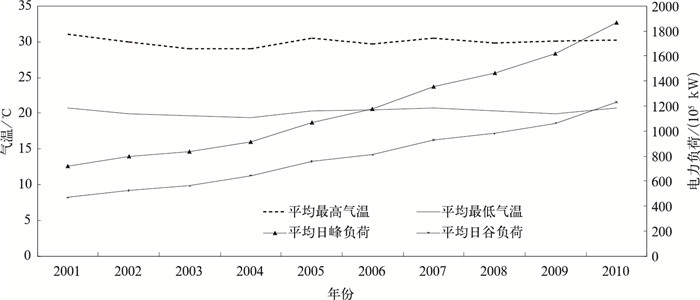Application and Verification of Accumulated Temperature Effects on Daily Peak Load and Daily Valley Load of Power
-
摘要: 从电力气象服务需求出发,利用2001—2010年5—9月河北省南电网逐日电力日峰负荷、日谷负荷与对应时间的气象资料,探讨晴热天气和闷热天气对电力日峰负荷、日谷负荷的影响特征。分析发现持续3 d以上的闷热天气相对晴热天气使电力日峰负荷、日谷负荷增长更显著;日最高气温32℃是引起河北省南电网日峰负荷增长的初始气温敏感点,35℃为强气温敏感点,38℃为极强气温敏感点,日最低气温25℃为引起日谷负荷增加的敏感气温临界点;建立了引入积温热累积效应的日峰负荷、日谷负荷多元回归气象预测模型,经2011—2013年应用检验,日峰负荷、日谷负荷预测平均相对误差分别为4.8%和3.5%,提高了预测准确率,对电力调度具有参考价值。Abstract: In order to meet needs for electric power of meteorological service, an analysis is made on the correlation between meteorological elements and electrical loads of electric network in Hebei Province. The meteorological data and electrical load data from May to September during 2001-2010 are used, and they are divided into sunny hot weather and muggy weather. Compared to the sunny hot weather, it shows that the daily peak load and daily valley load are increased significantly in muggy weather lasting three days or more. When daily maximum temperature reaches 32℃, daily peak load of power increase rapidly in Hebei Province, and 32, 35℃ and 38℃ of daily maximum temperature are three sensitive points for daily peak load of power to air temperature variation. During periods with daily maximum temperature more than or equal to 35℃, the daily peak load of power varies greatly according to the air temperature. When daily maximum temperature exceeds 38℃, considering 1℃ rising of daily maximum temperature, the daily peak load of power would increase 9.4%, and the air-conditioning cooling load of power would reach 50% of the daily peak load. When daily minimum temperature reaches 25℃, daily valley load of power increases rapidly, and 25℃ of daily minimum temperature is the sensitive point of daily valley load of power to air temperature variation. Introducing accumulated temperature effect as forecast factor, a meteorological electricity prediction model is established by using the multiple regression method, which can predict the peak and valley of meteorological electricity loads. The model is validated using historic data from 2011 to 2013, the average relative error of daily peak load is 4.8%, and that of the daily valley load is 3.5%, showing good prediction accuracy. The proposed model has reference significance for electric power dispatching.
-
表 1 2001—2010年5—9月晴热天气过程与日峰负荷、日谷负荷变化
Table 1 Variations of daily peak load and daily valley load of power in sunny hot weather from May to September during 2001-2010
时段 日峰负荷增量/(105 kW) 日谷负荷增量/(105 kW) 过程最高气温/℃ 过程最低气温/℃ 2001-07-11—13 102.8 29.9 37.1 23.5 2002-05-30—06-01 62.2 19.4 37.0 20.1 2002-06-03—07 62.0 14.1 38.1 22.0 2003-06-17—20 75.0 24.8 36.8 19.6 2004-06-09—11 53.1 41.4 37.5 19.7 2005-06-11—17 42.1 59.9 37.3 21.8 2005-06-19—21 107.1 85.7 40.3 24.1 2005-07-04—09 110.7 7.3 37.6 24.1 2007-06-06—10 91.9 31.0 37.8 22.0 2009-06-23—07-04 123.6 58.3 40.4 21.9 2010-06-27—29 67.5 27.5 38.1 23.1 平均 81.6 36.3 38.0 22.0 表 2 2001—2010年5—9月闷热天气过程与日峰负荷、日谷负荷变化
Table 2 Variations of daily peak load and daily valley load of power in muggy weather from May to September during 2001-2010
时段 日峰负荷增量/(105 kW) 日谷负荷增量/(105 kW) 过程最高气温/℃ 过程最低气温/℃ 2002-07-10—15 80.2 61.2 41.6 25.7 2002-07-30—08-04 81.1 38.6 36.2 24.8 2005-07-19—21 65.3 53.9 35.9 25.4 2005-08-11—15 120.7 66.5 35.1 25.8 2006-07-12—14 44.9 44.1 34.1 24.4 2006-08-08—13 26.5 39.4 34.8 25.0 2008-08-07—09 35.7 6.7 33.8 24.8 2009-07-20—22 184.6 142.2 33.9 26.0 2010-07-03—05 179.1 101.1 39.5 25.0 2010-07-22—31 123.6 37.3 25.4 平均 94.2 61.5 36.2 25.2 表 3 日最高气温升高1℃对应的日峰负荷气象变化量 (K) 及增加值 (M)
Table 3 Increment of meteorological variations of daily peak power with 1℃ increment of daily maximum temperature
Tmax/℃ K/% M/% [27, 28) -18.8 [28, 29) -10.4 8.4 [29, 30) -9.3 1.1 [30, 31) 0.5 9.8 [31, 32) 3.3 2.8 [32, 33) 18.2 14.9 [33, 34) 19.6 1.4 [34, 35) 21.6 2.0 [35, 36) 27.6 6.0 [36, 37) 30.9 3.3 [37, 38) 34.5 3.6 [38, 39) 43.9 9.4 [39, 45*) 48.2 4.3 注:*历史记录中南电网区域夏季极端最高气温为44.4℃。 表 4 日最低气温升高1℃对应的日谷负荷气象变化量及增加值
Table 4 Increment of meteorological variations of daily valley load of power with 1℃ increment daily minimum temperature
Tmin/℃ K/% M/% [20, 21) -7.0 [21, 22) -4.3 2.7 [22, 23) 5.0 9.3 [23, 24) 0.1 -4.9 [24, 25) 2.7 2.6 [25, 26) 17.3 14.6 [26, 27) 20.9 3.6 [27, 30*) 20.5 -0.4 注:*历史记录中南电网区域夏季日最低气温最大值为30.0℃。 表 5 2001—2010年5—9月逐日电力气象负荷与气象要素的相关系数
Table 5 The correlation between power load and meteorological elements from May to September during 2001-2010
气象要素 Fmax Fmin T 0.551 0.561 Tmax 0.542 0.535 Tmin 0.426 0.431 Bmax 0.430 Bmin 0.353 f -0.361 -0.338 R -0.228 -0.183 -
[1] 胡江林, 陈正洪, 洪斌, 等.基于气象因子的华中电网负荷预测方法研究.应用气象学报, 2002, 13(5):600-608. http://qikan.camscma.cn/jams/ch/reader/view_abstract.aspx?file_no=20020577&flag=1 [2] 罗慧, 巢清尘, 李奇, 等.气象要素在电力负荷预测中的应用.气象, 2005, 31(6):15-18. doi: 10.7519/j.issn.1000-0526.2005.06.003 [3] 付桂琴, 李运宗.气象条件对电力负荷的影响分析.气象科技, 2008, 36(6):795-800. http://www.cnki.com.cn/Article/CJFDTOTAL-QXKJ200806026.htm [4] 吴向阳, 张海东.北京市气温对电力负荷影响的计量经济分析.应用气象学报, 2008, 19(5):531-538. doi: 10.11898/1001-7313.20080503 [5] 张小玲, 王迎春.北京夏季用电量与气象条件的关系及预报.气象, 2002, 28(2):17-21. doi: 10.7519/j.issn.1000-0526.2002.02.004 [6] 郑贤, 唐伍斌, 贝宇, 等.桂林电网日负荷与气象因素的关系及其预测.气象, 2008, 34(10):96-101. doi: 10.7519/j.issn.1000-0526.2008.10.013 [7] 陈正洪, 洪斌.华中电网四省日用电量与气温关系的评估.地理学报, 2000, 55(增刊Ⅰ):34-38. http://www.cnki.com.cn/Article/CJFDTOTAL-DLXB2000S1006.htm [8] 付桂琴, 时青格, 刘建文.夏季高温对电力负荷的影响.电网技术, 2010, 34(增刊Ⅱ):506-509. http://www.cnki.com.cn/Article/CJFDTOTAL-JSDJ200402004.htm [9] Douglas M L C, Hency E W.Modeling the impact of summer temperatures on nationalelectrlcity consumption.J Appl Meteorol, 1981, 20(12):1415-1419. doi: 10.1175/1520-0450(1981)020<1415:MTIOST>2.0.CO;2 [10] 段海来, 千怀遂.广州城市电力消费对气候变化的响应.应用气象学报, 2009, 20(1):80-87. doi: 10.11898/1001-7313.20090110 [11] 张海东, 孙照渤, 郑艳, 等.温度变化对南京城市电力负荷的影响.大气科学学报, 2009, 32(4):536-542. http://www.cnki.com.cn/Article/CJFDTOTAL-NJQX200904011.htm [12] 李雪铭, 葛庆龙, 周连义, 等.近二十年全球气温变化的居民用电量响应——以大连市为例.干旱区资源与环境, 2003, 17(5):54-58. http://www.cnki.com.cn/Article/CJFDTOTAL-GHZH200305010.htm [13] 张自银, 马京津, 雷杨娜.北京市夏季电力负荷逐日变率与气象因子关系.应用气象学报, 2011, 22(6):760-765. doi: 10.11898/1001-7313.20110615 [14] 贺芳芳, 史军.上海地区夏季气温变化对用电负荷的影响.长江流域资源与环境, 2011, 20(12):1462-1467. http://www.cnki.com.cn/Article/CJFDTOTAL-CJLY201112007.htm [15] 阎访, 陈静, 车少静.石家庄夏季用电量对天气的响应及其预测模型.甘肃气象, 2009, 27(3):282-287. http://www.cnki.com.cn/Article/CJFDTOTAL-GSQX200903015.htm [16] 罗森波, 纪忠萍, 马讉华, 等.2002—2004年广东电力负荷的变化及预测.热带气象学报, 2007, 23(2):153-161. http://www.cnki.com.cn/Article/CJFDTOTAL-RDQX200702006.htm [17] 贺芳芳, 徐家良, 周伟东, 等.上海地区高温期气象条件对用电影响的评估.高原气象, 2008, 27(增刊Ⅰ):210-217. http://www.cnki.com.cn/Article/CJFDTOTAL-GYQX2008S1028.htm [18] 钟利华, 周绍毅, 邓英姿, 等.广西近年高温干旱气象灾害及对电力供求的影响.灾害学, 2012, 22(3):81-84. http://cpfd.cnki.com.cn/Article/CPFDTOTAL-ZGQX200711011114.htm [19] 陈辉, 黄卓, 田华, 等.高温中暑气象等级评定方法.应用气象学报, 2009, 20(4):451-457. doi: 10.11898/1001-7313.20090409 [20] 黄卓, 陈辉, 田华.高温热浪指标研究.气象, 2011, 37(3):345-351. doi: 10.7519/j.issn.1000-0526.2011.03.013 [21] 郭建平, 田志会, 张娟娟.东北地区玉米热量指数的预测模型研究.应用气象学报, 2003, 14(5):626-633. http://qikan.camscma.cn/jams/ch/reader/view_abstract.aspx?file_no=20030577&flag=1 [22] 刘红亚, 曹亮.上海市电力负荷与气象因子关系及精细化预报.应用气象学报, 2013, 24(4):455-463. doi: 10.11898/1001-7313.20130408 -


 设为首页
设为首页 加入收藏
加入收藏



 下载:
下载:


